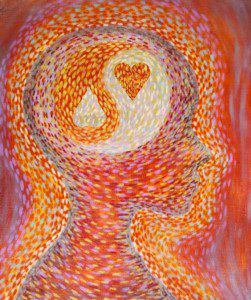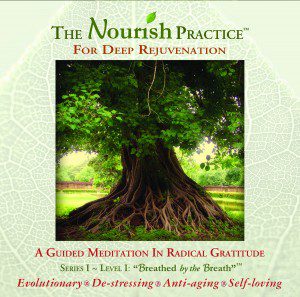By Jack Adam Weber L.Ac., Dipl. C.H.
Contributing Writer for Wake Up World
Peace, harmony, and love don’t just come from the heart. Not only is this because what we call the “heart” is mediated by the limbic system in our brain, where our emotional centers are located, but because thinking well and critically is also crucial for these desirable, yet elusive qualities. Such critical thinking and self-reflection—what I am here calling “mind”—are functions of the prefrontal cortex, that unique part of our brains especially developed in humans.
Also, to help clarify common confusions between “heart” and mind” as they relate to our brains and emotions, consider that we feel our emotions in our body because when emotions are triggered, our brains release neurochemicals and hormones from endocrine glands, which also signal our muscles to react in certain ways, which in turn relay back to the brain in a feedback loop. Let’s consider an example of how our minds and feeling selves interact to create what describe as peace and love, or disharmony and conflict.
REAL-LIFE NEUROSCIENCE
If I misunderstand something you say I might soon create beliefs about you, which can lead to judgments, actions, and even harsh words, creating hurt. If I don’t use my discerning mind to discover what you said, and more importantly, what you actually meant by what you said, in order to be sure I am hearing you correctly (as interpersonal reality), I will likely cause you and myself suffering. This is how our hearts can suffer when we don’t use our minds to help this emotional part of our brains out.
Therefore, when considering love, when considering peace and harmony, remember that our “hearts”—our emotional body and feeling selves—often need our minds to inform our emotional responses. Our minds must make sure to get the facts straight (“is it true?”) so that the beliefs we formulate from our perceptions (or imaginations!), which in turn influence our responses (or reactions!), are accurate and in alignment with and appropriate to current reality.
New neuroscience research, particularly that of Antonio Damasio, tells us that many of our perceptions and decisions are based on our emotions. We therefore have to be vigilant about what conclusions we come to about reality based on what our emotional conditioning has been. If we harbor significant unresolved hurts, for example, we will tend to interpret reality, and indeed somatically react to it, in ways that we have been conditioned and which support our emotional stories. Our emotional stories are the beliefs we develop over time about ourselves as a result of our emotional wounds. Consider a hypothetical example: if your spouse is aloof one night because of nothing personal towards you, you might (consciously or more likely unconsciously) equate him (or her) with the way a parent was distant and unloving, and assume a state of smallness and shame…and soon, likely blame!
In this scenario, you might feel sad, angry, and helpless. These are your emotional wounds, which likely carry over from childhood or past relationships. The emotional story—(usually subconscious) beliefs about yourself—you might develop as result of these wounds is that you are unlovable, you are unworthy, you don’t matter. Once we start feeling and on some level thinking this combination of emotions and story, we can quickly experience full-blown episodes of upset.
If we don’t nip this procession in the bud and sort it out with good thinking and emotional intelligence, this blame can turn into other expressions of aggression, anxiety, violence, and withdrawal. All these feelings, expressions, and actions will likely then trigger reactions in your partner, creating a mess in a hurry. Sound familiar? In contrast, when two people can find it in themselves to genuinely care enough to slow things down and non-defensively sort through misunderstandings, responsibly look into personal emotional triggers, resultant beliefs, and the errant reactions based on them, then the more intimacy, joy, and vitality can be gained and contributed towards joy, including the joy of working through such tight spots and emerging more connected and wiser. In case you were wondering, this process does not ultimately deny any emotions; it just wisely works with our emotions so that other parts of us are not overrun by them.
What we think, then, is heavily influenced by our emotional memories. This is an example of how our emotional body affects our mind. It also shines a light on why it is so important to do our historical emotional healing work—so that we become very familiar with what are our emotional wounds in order to both a) heal, dissolve, and integrate their pain and influence on us and b) be able to notice them when they crop up in our current relationships as a signal to refrain, take space, and think through what is happening and engage our own emotional healing work. When our old hurts are present from the past, we are most likely to create more pain and suffering by projecting these feelings onto present situations and onto the world in general.
By the way, I think this is a big reason why humans are also so destructive to the Earth. The saying goes, “Hurt people hurt others.” We treat all others the way we were treated, until we actually change ourselves, which involves in-depth emotional work best done in the context of body-centered psychotherapy. Specifically, a failure to grieve our love losses, which grief clears our pain, is responsible for the violence we do onto others, including Nature. So, to be truly sustainable people, we might have to do our emotional work, which I call inner activism—healing our emotional wounds to become people capable of more pervasively loving the world and making the right choices and harmoniously and steadfastly working together for a better world.
Now back to our interpersonal example. So, mind must inform emotions according to fact. Therefore, first try to find out why your spouse is aloof. If you can’t discover anything from him or her, try not to make up stories, which stories will feed your emotional upset (this is the mind working against the heart). If you still feel like yuck, then try tracing your feelings back to the past where they likely developed, until you get more information from your partner. By the same token, emotions must be made conscious so that we know what subterranean influences are affecting our perceptions and what we have come to believe (e.g., am I unconsciously reacting to my partner because of my past experiences with dad or previous partner?). In other words, are your feelings generating a story about your spouse because of what has hurt you in the past?
TURNING OFF TO TURN IT ON
While there are times when we have to turn off our minds in order to feel deeply, these deep feeling states are maximized when we enter them at appropriate times. Even in “pure feeling states” we can maximize their integration into our lives when we rationally reflect on them. As an example, during emotional process work when one is not sure of what one is feeling, it is helpful to sink into one’s body and simply feel. While feeling these feelings is healing because they are made conscious and thereby “released” to some degree, our overall healing and integration is aided also by reflecting on and contexting these feelings, discovering meaning in them, and seeing how our past affects us presently.
What I find less appreciated is that we sometimes also have to turn off our “hearts”—meaning to restrain our feelings. Sometimes we have to not be so open, so to protect ourselves, or so not to gush our emotional wounds all over one another. Being emotionally “open” all the time, without using discretion as to when it is appropriate, can injure us and others, and ironically, close down avenues of experience. For example, if I am emotionally “open-hearted” to a violent person, this is likely to harm me. Similarly, if I am unrestrained in acting on my desires in the name of “openness,” this can get me into a load of a mess rather quickly.
We would therefore be wise to exercise a modicum of critical thinking to help us responsibly regulate our emotions in the presence of others. When we don’t, we can be abusive and inappropriate, since what we feel is not always, or even usually, based in the present. Our feelings are not “wrong.” They are just not appropriately expressed to another, nor warrant our believing them to be about the present to the extent that we develop stories (assumptions, judgments, and beliefs) about the other. We can, however, be accepting and expressive unto ourselves, and/or a trusted and consenting other, of all our feeling states and emotions. In fact, when we sense our core wounds are triggered, this is often the most productive way to go.
Reading this article is itself an exercise in critical thinking. Realizing any truth in what is being shared here (even if by countering what is said and coming to a conclusion in the process that is true in reality) is an example of how thinking well can help us sort out the territory of mental-emotional phenomena, thereby helping us to think better and to express ourselves more appropriately and respectfully. Bothering to understand and feel into what is being said here can help to foster interest in using one’s mind well and to be more accepting and to work with one’s emotions, which serves to foster more peace and love.
Unfortunately, too often spirituality and love are associated with turning off the mind. Sometimes this is the case when our minds are neurotic, runaway trains. But if we can cultivate our thinking (as described herein) to be an ally (as described above), rather a nuisance, it can help us to more joyfully love and care for ourselves and one another and the Earth. Mind-body practices, meditation, exercise, good nutrition, self-restraint, social support, selfless service, and meaningful work all can help us to enact the recommendations in this essay.
Let us then remember that our “hearts” need our good minds, and our good minds need our healed “hearts” in order to integrate our emotions and thinking according to everyday reality. This allows us to open our minds to new possibilities and to effect our own mental-emotional-spiritual healing, which in turn allows us to communicate and act in grounded, wise, loving, productive, compassionate and effective ways in everyday life.
IN CONCLUSION: CONSIDER THE ALTERNATIVE
If all this sounds too complex to you, I invite you to consider the alternative: how difficult it is to sort out and recover from hurt feelings and arguments that never get resolved and forgiven. How pesky and confusing it can be to not know how to integrate our minds and our emotions, much less in the name of love, harmony, and sustainability. Wars are waged, children estranged, relationships break up, friendships lost, and ecosystems destroyed because of these very dynamics gone wrong. This work is the inner path to sustainability for all our relationships.
To experience this process with another person, it requires that you share similar values and have a similar passion for growth and depth. If you don’t have that kind of relationship, you can cultivate the faculties for this kind of integration on your own, in relation to yourself, and with any others. This latter alternative is still very worthwhile, as it allows you to upgrade your humanity, feel better about yourself, treat the world more kindly, and attract more quality people to you.
We are complex, amazing creatures. I think a big problem is that we try to dumb down relationships as well as the complexity of life and ourselves. The result is that we don’t learn about the tools in our tool kit and we don’t bother to read and diligently study the requisite instruction manual for being human. It’s high time that we own up to our complexity, that we exercise more discipline, self-awareness, responsibility, and maturity in working with our minds and emotions. We and our dear Earth are in enough pain from our negligence.
When we embrace the complexity and difficulty of all that we are, life becomes paradoxically simpler and more enjoyable. Life often goes more smoothly and the journey becomes fascinating rather than annoyingly mysterious and problematic. And we get to understand, celebrate, and enjoy the complex and amazing set of holistic body-mind-soul tools that we have been gifted. We become wiser to not jump to conclusions. We more often remember to ask questions before assuming we understand correctly. We are self-aware enough to pause and to use restraint in engaging when we sense that our emotional triggers are activated. We sense when we are tired and emotionally labile and refrain during these times from making big decisions or engaging in sensitive subjects with others. And, if we do engage, we can learn to respectfully cease and desist if it begins to get out of hand. We learn how to be with our difficult feelings, which is the beginning of the solution not to displace that hurt onto others. This way, we learn how to avoid and diffuse hurtful arguments. And in the process of choosing all this we discover that we create more love, depth, compassion, true healing, and harmony. At the very least, we learn how to navigate and process our experiences with more depth, meaning, and passion, which is itself enriching and healing.
It’s said that changing the world begins with ourselves. I have found this to be true. If we can’t effect healing our own hearts and create peace and love in our interpersonal relationships, then we can’t expect the world to change. In contrast, when we can find healing and resulting harmony in our small circle of relations, beginning with ourselves, we can then realistically contribute healing to the world and help it shift of its own accord for the better.
The Nourish Practice
Jack Adam Weber’s “The Nourish Practice” is an easy, guided meditation-Qi Gong practice in radical gratitude and self-love. It is an Earth-based, body-centered practice — at once physiological and mythological — that is deeply relaxing and replenishing, especially for modern-day burn-out syndrome, and requires little physical effort.
The Nourish Practice “resets your nervous system” and fosters a rich inner life. You can purchase The Nourish Practice as a CD or Digital Download here.
Previous articles by Jack Adam Weber:
- Relationships: The Costs of Staying When We Should Leave
- Emotional Work
- Choosing a Partner – How to Avoid Relationship Suicide
- Re-Thinking Love: Why Our Hearts Must Also Be Minded
- Spirituality – Reality Check
- 11 Crucial Tips for Better Digestive Health
- Shadow Work: Becoming a Sustainable Light Worker (Part 1)
- Oneness in Action: The GMO Eradication Movement
- After the Hurricane: Lessons from the Heart of Nature
- Relationships: How They Can Make Us Happier
- Heartbreak – Loving Ourselves Through Difficult Times
About the author:
 Jack Adam Weber, L.Ac. is a Chinese medicine physician, author, celebrated poet, organic farmer, and activist for body-centered spirituality. His books, artwork, and provocative poems can be found at his website PoeticHealing.com. He is also the creator of The Nourish Practice, an Earth-based rejuvenation meditation. Weber is available by phone for medical consultations and life-coaching.
Jack Adam Weber, L.Ac. is a Chinese medicine physician, author, celebrated poet, organic farmer, and activist for body-centered spirituality. His books, artwork, and provocative poems can be found at his website PoeticHealing.com. He is also the creator of The Nourish Practice, an Earth-based rejuvenation meditation. Weber is available by phone for medical consultations and life-coaching.
You can connect with Jack Adam Weber on Facebook or by emailing [email protected].

If you've ever found value in our articles, we'd greatly appreciate your support by purchasing Mindful Meditation Techniques for Kids - A Practical Guide for Adults to Empower Kids with the Gift of Inner Peace and Resilience for Life.
In the spirit of mindfulness, we encourage you to choose the paperback version. Delve into its pages away from screen glare and notifications, allowing yourself to fully immerse in the transformative practices within. The physical book enriches the learning process and serves as a tangible commitment to mindfulness, easily shared among family and friends.
Over the past few years, Wake Up World has faced significant online censorship, impacting our financial ability to stay online. Instead of soliciting donations, we're exploring win-win solutions with our readers to remain financially viable. Moving into book publishing, we hope to secure ongoing funds to continue our mission. With over 8,500 articles published in the past 13 years, we are committed to keeping our content free and accessible to everyone, without resorting to a paywall.








